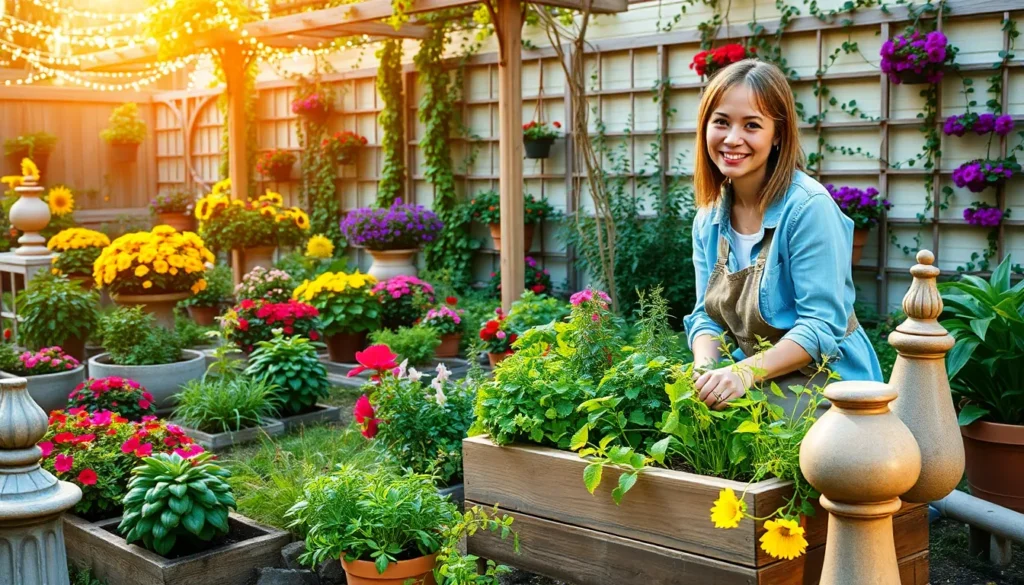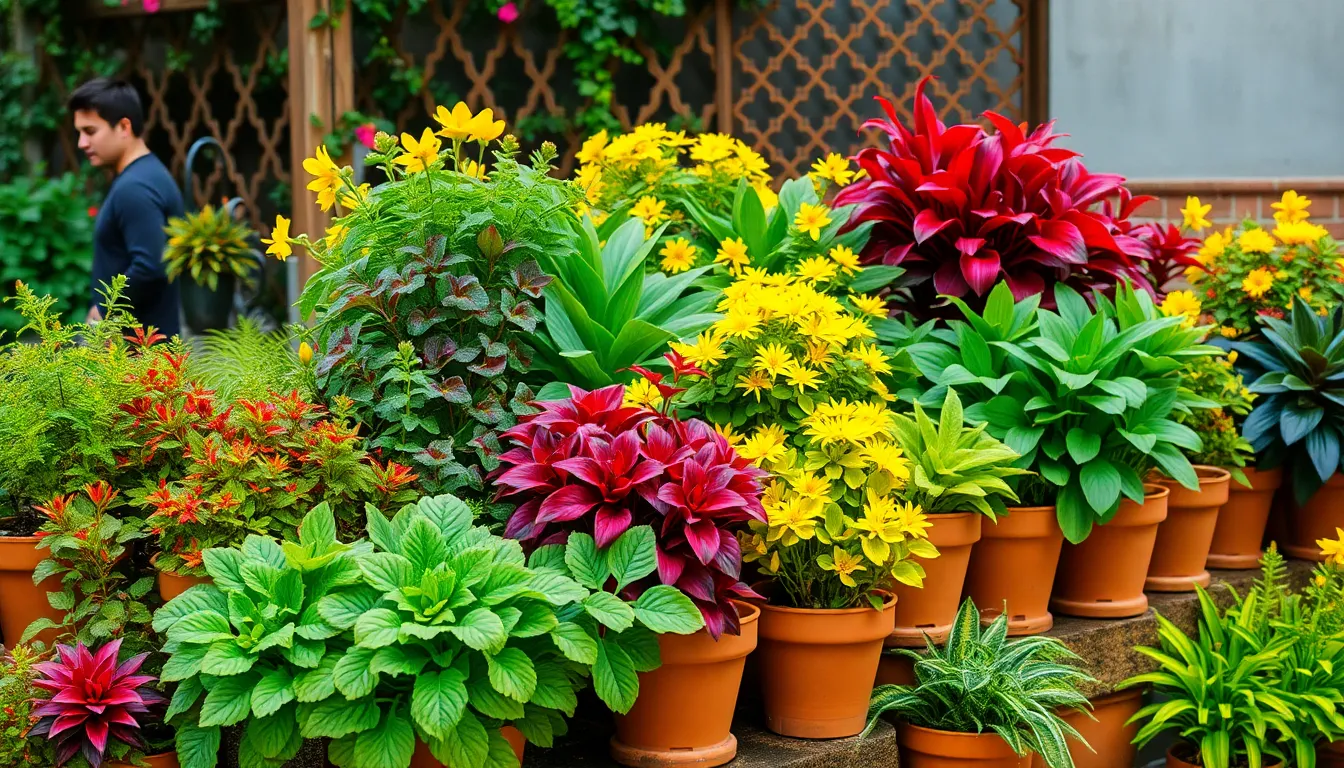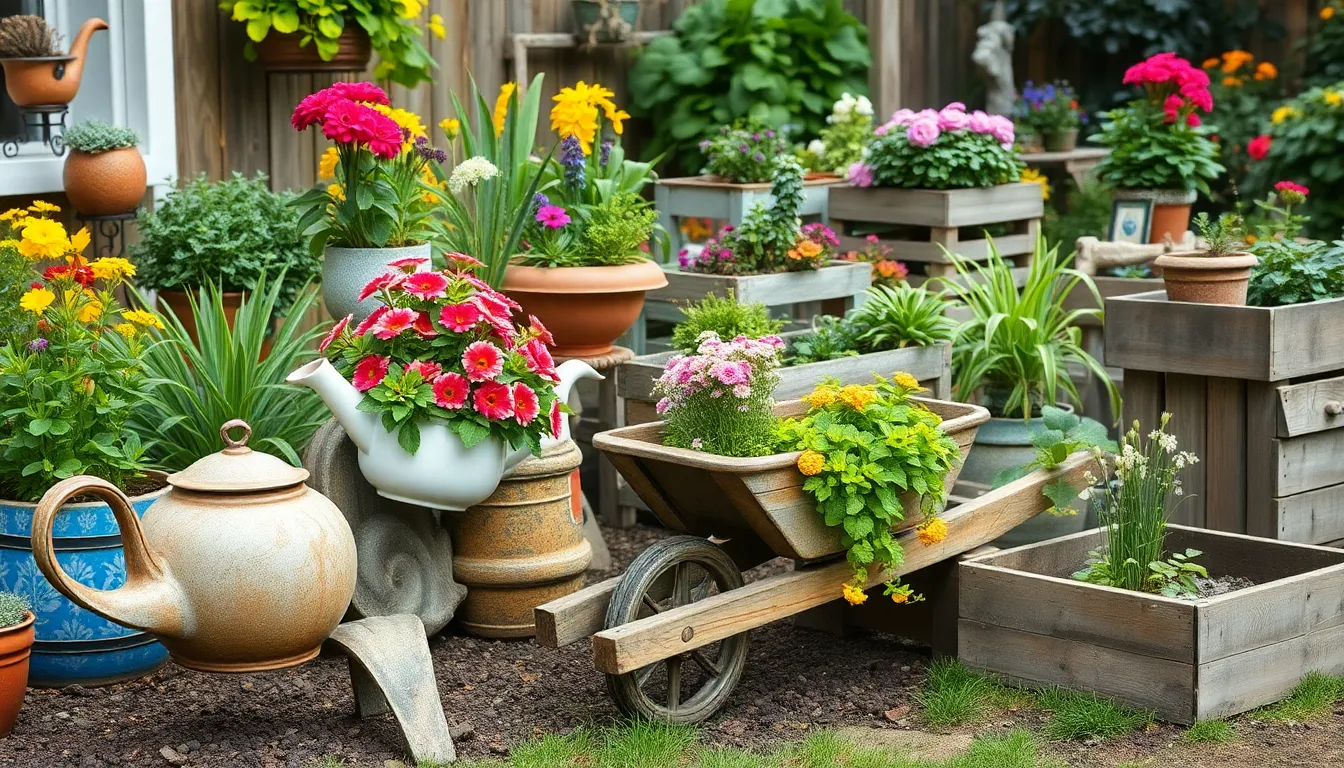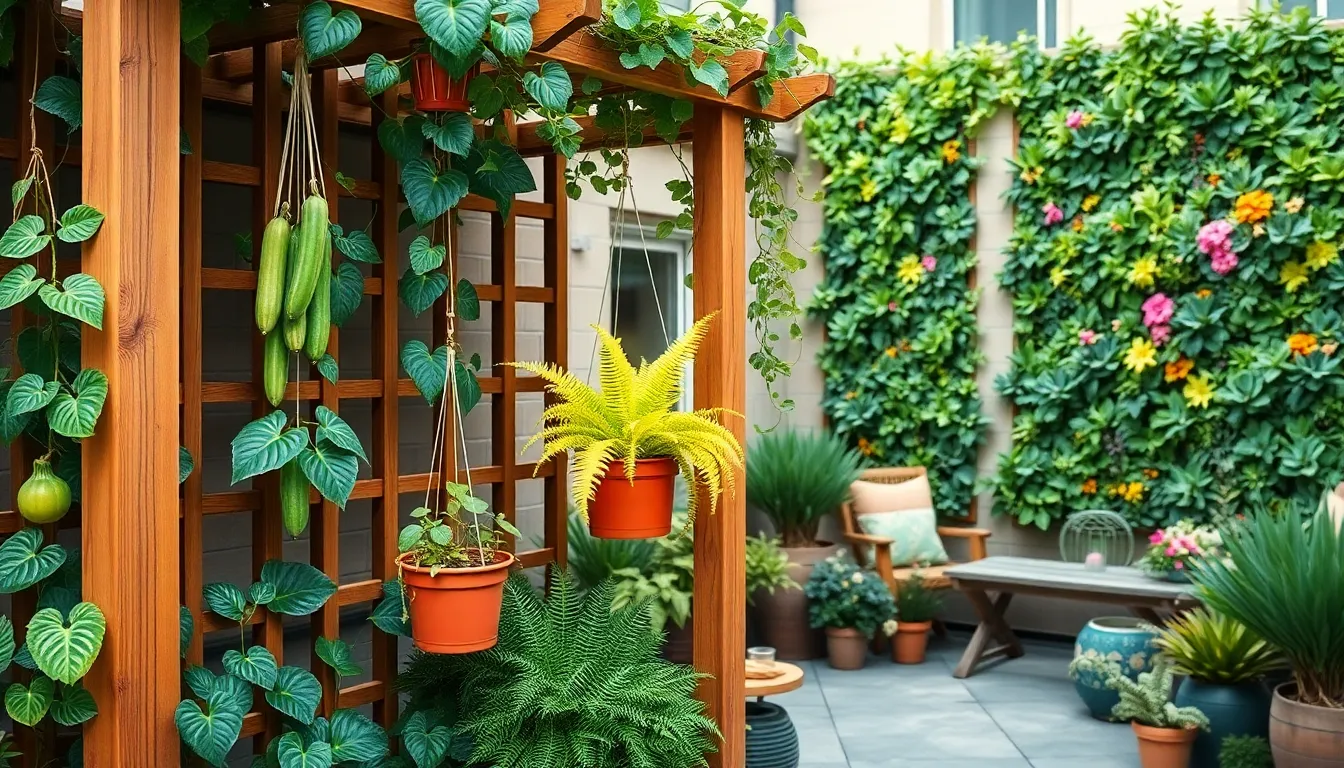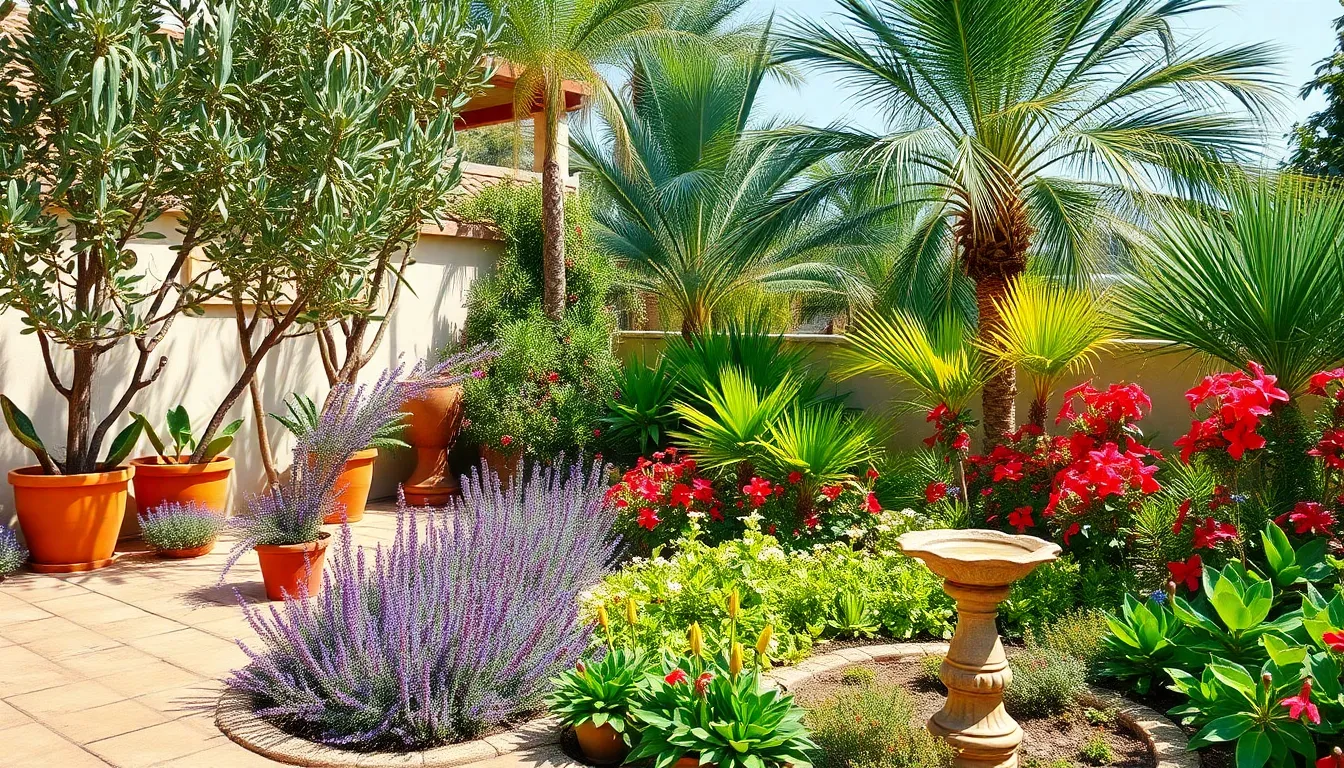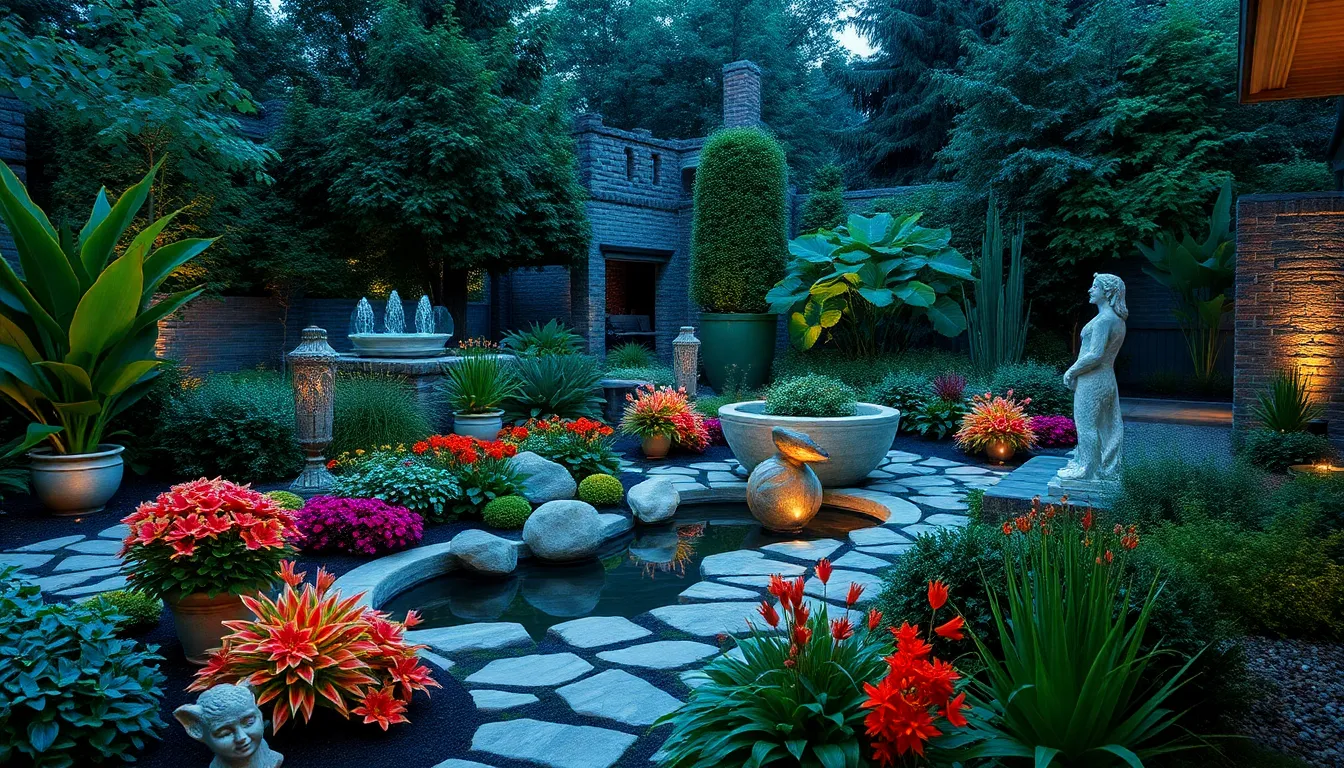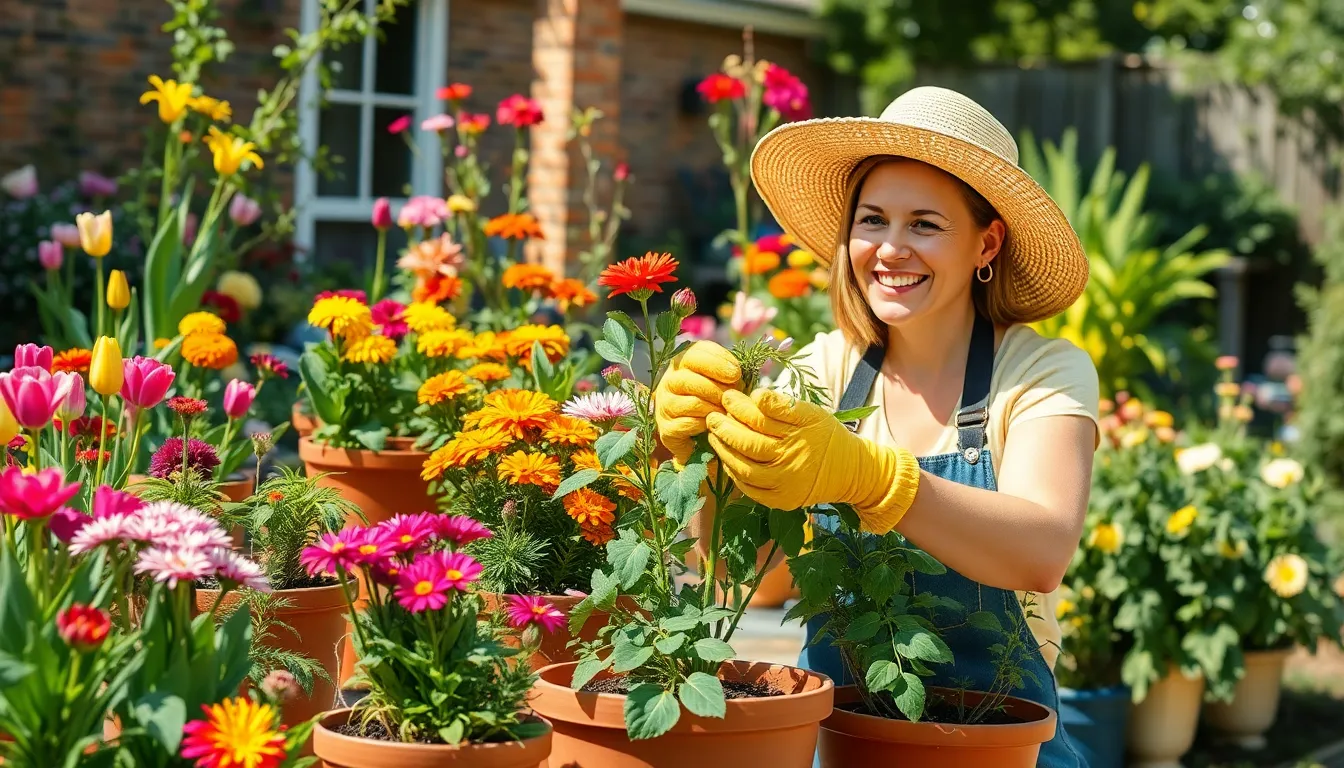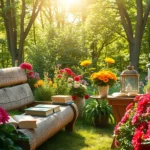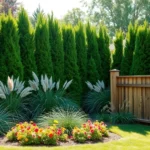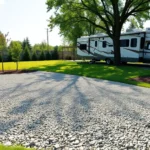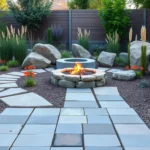Transform your outdoor space into a stunning sanctuary with creative plant decor that’ll make your neighbors green with envy. We’re diving into the industry of outdoor garden design where strategic plant placement meets artistic flair to create breathtaking landscapes that boost your home’s curb appeal and property value.
Whether you’re working with a sprawling backyard or a cozy balcony we’ve got game-changing ideas that’ll maximize every square inch of your outdoor area. From vertical gardens that draw the eye upward to layered plantings that create depth and dimension these proven techniques will turn your garden into an Instagram-worthy oasis.
Ready to discover how the right plant combinations can create year-round interest while requiring minimal maintenance? We’re sharing insider secrets that industry designers use to create outdoor spaces that feel both luxurious and inviting. Your dream garden is closer than you think.
Choose the Right Plants for Your Outdoor Garden Decor
Plant selection forms the foundation of successful outdoor garden decor that thrives year after year. We’ll guide you through the essential factors that determine which plants will flourish in your exact space while creating the visual impact you desire.
Consider Your Climate Zone and Growing Conditions
Understanding your USDA hardiness zone determines which plants will survive your local winters and flourish in your exact climate conditions. We recommend checking your zone’s average minimum temperatures before selecting any permanent plantings for your outdoor garden decor.
Evaluate your garden’s sun exposure by observing different areas throughout the day to identify full sun (6+ hours), partial sun (3-6 hours), and shade locations. Plants like roses, lavender, and ornamental grasses thrive in full sun areas, while hostas, ferns, and begonias prefer shadier spots.
Test your soil’s pH level using a simple soil testing kit, as most plants prefer slightly acidic to neutral soil (pH 6.0-7.0). Drainage plays a crucial role in plant health, so we suggest adding compost or sand to heavy clay soils that retain too much moisture.
Consider your local rainfall patterns and plan for supplemental watering during dry spells, especially for container plants and newly established garden beds.
Select Plants That Complement Your Garden’s Style
Modern garden styles benefit from clean lines created by ornamental grasses like fountain grass, architectural plants such as agave, and structured shrubs including boxwood or Japanese yew. We choose plants with bold foliage and geometric forms to enhance contemporary outdoor spaces.
Cottage garden decor thrives with romantic, flowing plants like climbing roses, delphinium, hollyhocks, and sweet peas that create an informal, abundant appearance. Mix different heights and textures to achieve that charming, slightly wild cottage garden aesthetic.
Mediterranean style gardens showcase drought tolerant plants such as rosemary, thyme, olive trees, and succulents that require minimal water while providing year round structure. Stone planters and terra cotta containers enhance this sun loving plant palette.
Tropical garden themes come alive with bold foliage plants like elephant ears, bird of paradise, hibiscus, and colorful crotons that create lush, exotic outdoor garden decor even in non tropical climates.
Mix Seasonal Blooms for Year-Round Color
Spring bulbs including tulips, daffodils, and crocuses provide the first burst of color after winter, followed by flowering trees like cherry blossoms and magnolias that create stunning focal points in your garden design.
Summer annuals such as petunias, marigolds, zinnias, and impatiens deliver continuous color from late spring through the first frost when planted in strategic locations throughout your outdoor space. We plant these in containers and border areas where their vibrant blooms create maximum visual impact.
Fall brings rich colors through ornamental kale, chrysanthemums, asters, and the changing foliage of deciduous trees and shrubs like Japanese maples and burning bush.
Winter interest comes from evergreen plants, ornamental grasses that maintain their structure, and plants with colorful bark such as red twig dogwood and birch trees that provide visual appeal during dormant months.
| Season | Key Plants | Bloom Duration | Maintenance Level |
|---|---|---|---|
| Spring | Tulips, Daffodils, Cherry Trees | 2-4 weeks | Low |
| Summer | Petunias, Marigolds, Roses | 3-4 months | Medium |
| Fall | Mums, Asters, Ornamental Kale | 6-8 weeks | Low |
| Winter | Evergreens, Holly, Winterberry | All season | Very Low |
Create Eye-Catching Plant Arrangements and Displays
With your plant selection complete, we’ll transform your outdoor space into a visual masterpiece through strategic arrangement techniques. These proven design principles will elevate your garden from ordinary to extraordinary.
Design Layered Plantings with Varying Heights
Arranging plants in tiers creates dramatic depth and visual appeal in your outdoor garden space. Position taller plants or climbing varieties at the back or center of your display, with medium height specimens filling the middle ground and low growing plants or ground covers establishing the foreground. This strategic placement ensures every plant receives adequate sunlight exposure while creating a natural amphitheater effect.
Raised beds and tiered planters maximize your vertical space potential. Terra cotta pots stacked in ascending tiers work exceptionally well for this technique, allowing you to showcase multiple plant varieties in a compact footprint. Vertical arrangements also improve airflow circulation between plants, promoting healthier growth patterns and reducing disease risk.
Climbing plants on trellises or decorative arches add impressive vertical elements. These structures serve dual purposes by providing support for vigorous climbers while creating stunning focal points that draw the eye upward throughout your garden design.
Use Color Theory to Create Stunning Combinations
Following the natural rainbow sequence produces vibrant, harmonious plant displays. Arrange flowering plants in red, orange, yellow, green, blue, and violet progressions to create energizing color flows that naturally please the eye. This scientific approach eliminates guesswork while ensuring your combinations always complement each other.
Foliage color variations maintain visual interest beyond blooming seasons. Deep green leaves paired with variegated or silver foliage plants create subtle contrasts that persist year round. Burgundy, chartreuse, and bronze leaf specimens add richness to your palette even when flowers aren’t present.
Color psychology influences the mood your garden creates. Warm colors like reds, oranges, and yellows energize outdoor spaces and create welcoming environments. Cool blues, purples, and whites promote tranquility and relaxation, making them perfect for meditation gardens or peaceful retreat areas.
Group Plants by Texture and Foliage Patterns
Contrasting leaf shapes and textures create compelling visual dynamics in plant groupings. Broad leafed hostas paired with delicate, feathery astilbe foliage produces striking textural contrast that catches attention immediately. Fine needled conifers alongside bold tropical leaves establish dramatic juxtapositions that define garden sections.
Similar texture groupings unify design areas while contrasting textures highlight individual specimens. Clustering plants with comparable leaf patterns creates cohesive zones within larger garden designs. Strategic placement of dramatically different textures breaks up monotony and establishes natural transition points between garden rooms.
Variegated patterns and unique leaf edges add complexity beyond flower color alone. Striped, spotted, or cream edged foliage provides year round decorative elements that maintain interest during dormant flowering periods. These distinctive patterns serve as living artwork that enhances your outdoor space regardless of seasonal changes.
Incorporate Unique Containers and Planters
Distinctive containers transform ordinary garden plants into stunning focal points that showcase your personal style. We’ll explore how creative planters can elevate your outdoor space beyond traditional ceramic pots.
Repurpose Vintage Items as Creative Plant Holders
Vintage treasures offer endless possibilities for unique plant displays while promoting sustainable gardening practices. Old crates work perfectly for herb gardens or cascading flowers, creating rustic charm that complements cottage-style landscapes. Antique teapots make delightful holders for small succulents or trailing plants, adding whimsical touches to patios and windowsills.
Weathered wheelbarrows serve as mobile garden features that we can relocate based on seasonal needs or sunlight requirements. Wooden boxes from wine crates or apple orchards provide authentic farmhouse appeal when filled with colorful annuals. These repurposed items give your garden an eclectic vibe while reducing waste and creating conversation starters for visitors.
Choose Weather-Resistant Materials for Durability
Selecting the right materials ensures your planters withstand outdoor elements year after year without compromising style or functionality. Different materials offer distinct advantages depending on your climate and maintenance preferences.
| Material | Benefits | Best For |
|---|---|---|
| Concrete | Extreme durability, temperature regulation, wind resistance | Permanent installations, large plants |
| Aluminum | Lightweight, rust-resistant, powder-coat options | Moveable displays, contemporary designs |
| Stainless Steel | Corrosion-resistant, premium appearance | Modern gardens, high-end installations |
| Corten Steel | Unique aesthetic, rust and corrosion resistant | Industrial designs, statement pieces |
| Fiberglass | UV resistant, low maintenance, versatile | Various outdoor conditions |
| Cedar/Redwood | Natural rot resistance, insect protection | Traditional gardens, organic appeal |
| Teak | High oil content, water-resistant | Luxury outdoor spaces |
Concrete planters excel in extreme weather conditions and help regulate soil temperature, benefiting plant health throughout seasonal changes. Metal options like aluminum provide lightweight portability while stainless steel offers premium durability for upscale garden designs. Wood varieties such as cedar and teak bring natural beauty with built-in weather resistance, though applying sealants extends their lifespan and UV protection.
Scale Container Size to Match Plant Growth
Proper container sizing directly impacts plant health and garden aesthetics over time. Small containers restrict root development and limit nutrient uptake, while oversized pots create water retention problems that can lead to root rot.
Consider the mature size of your plants when selecting containers to ensure adequate space for healthy root expansion. Perennials need room to establish extensive root systems, while annuals require less space but benefit from containers that accommodate their full growing season. Trees and large shrubs demand substantial containers that provide stability against wind and support their weight as they mature.
Match container depth to root growth patterns, with deep-rooted plants like tomatoes needing tall planters and shallow-rooted herbs thriving in wider, shorter containers. We recommend choosing containers approximately one-third larger than the plant’s current root ball to allow for healthy growth without overwhelming the plant with excess soil moisture.
Add Vertical Elements to Maximize Garden Space
Vertical gardening transforms limited ground space into expansive growing opportunities by utilizing upward dimensions that often go unused. These space-maximizing techniques create layered visuals while allowing us to grow more plants in smaller areas, making them perfect for urban gardens and compact outdoor spaces.
Install Living Walls and Trellises
Living walls create stunning vertical displays by mounting plant panels directly onto existing fences or building sides. These green wall systems accommodate various plant types including succulents, perennials, and shade-loving species that add rich texture and vibrant color to vertical surfaces. We can attach these living wall panels to any sturdy vertical structure, instantly transforming blank walls into thriving garden features.
Trellises support climbing vegetables like beans and cucumbers while serving dual purposes as privacy screens and garden room dividers. These versatile structures help plants grow upward rather than sprawl across valuable ground space, maximizing our planting area efficiently. Installation requires securing the trellis firmly to handle the weight of mature climbing plants throughout the growing season.
Create Hanging Gardens with Suspended Planters
Suspended planters bring greenery to eye level and above, creating floating garden displays that double as living art installations. We can hang these planters from pergolas, covered patios, or specially constructed overhead frames to showcase trailing plants and compact varieties. Macramé hangers filled with ferns and flowering plants add bohemian charm while maximizing vertical growing space.
DIY hanging garden projects include wooden slat walls with attached planter boxes that create modular vertical growing systems. These custom answers allow us to adjust planter placement based on plant needs and seasonal changes. Weight distribution becomes crucial when planning suspended gardens, requiring strong anchor points and proper support systems.
Use Climbing Plants to Cover Structures
Climbing plants like grapevines, pole beans, and cucumbers transform basic garden structures into lush, productive features that provide both beauty and function. These vigorous growers quickly cover pergolas, arbors, and fences while delivering edible harvests and natural shade. We can even train climbing melons on sturdy overhead supports for unique vertical fruit production.
Structural coverage with climbing plants creates natural privacy screens while reducing summer heat through evapative cooling. These living coverings require initial training and periodic pruning to maintain desired growth patterns and prevent structural damage. Popular climbing varieties thrive in most climates, making this vertical strategy accessible for gardens across different growing zones.
Design Themed Garden Sections
Creating distinct garden sections with cohesive themes brings order and visual intrigue to outdoor spaces. We’ll explore three popular themed approaches that transform any garden into a curated industry masterpiece.
Establish a Mediterranean-Style Plant Corner
Mediterranean gardens feature drought-tolerant plants that thrive in hot, dry climates. Olive trees serve as stunning anchors for this design style, while lavender and rosemary provide fragrant borders that require minimal maintenance. Drought-resistant ornamental grasses like fountain grass or blue fescue add movement and texture between flowering elements.
Stone and terracotta containers enhance the authentic Mediterranean aesthetic. We recommend grouping pots of varying heights to create visual layers, using warm earth tones that complement the natural industry. Gravel pathways connect different plant groupings while providing excellent drainage for these water-wise plants.
Rustic benches and weathered wood accents complete the southern European atmosphere. Position seating areas near herb clusters so you can enjoy the aromatic benefits of rosemary, thyme, and oregano. These practical plants thrive with minimal water while providing fresh ingredients for cooking.
Create a Tropical Paradise with Exotic Plants
Tropical gardens emphasize lush, dense plantings with dramatic vertical layering. Tall palms like Areca or Majesty palms create an impressive canopy, while giant bird of paradise plants add architectural interest with their paddle-shaped leaves. Hibiscus and bougainvillea provide vibrant color bursts throughout the growing season.
Deep green foliage forms the foundation of successful tropical designs. Layer different leaf textures and sizes to create depth, using broad-leafed plants like elephant ears at ground level and feathery palms above. This vertical stratification mimics natural rainforest environments and maximizes visual impact.
Moisture requirements and shade preferences guide tropical plant placement. Most tropical species prefer partially shaded locations with consistent watering, making them ideal for areas near irrigation systems. For drought-prone regions, we suggest selecting hardy tropical alternatives like pineapple guava or certain palm varieties that tolerate drier conditions.
Build a Native Plant Wildlife Garden
Native plants support local ecosystems while attracting beneficial wildlife like birds and butterflies. These indigenous species require less water and maintenance because they’re naturally adapted to regional soil and climate conditions. Research your area’s native plant database to identify trees, shrubs, and wildflowers that originally grew in your location.
Habitat diversity increases wildlife activity and creates year-round interest. Mix flowering perennials with berry-producing shrubs and seed-bearing grasses to provide food sources throughout different seasons. Native oak trees support over 500 species of butterflies and moths, making them excellent centerpiece choices.
Water features enhance the wildlife-friendly environment significantly. Birdbaths positioned at varying heights accommodate different bird species, while small ponds or shallow water dishes serve ground-dwelling creatures. These additions transform your native garden into a thriving network that supports local biodiversity.
Enhance Your Garden with Decorative Plant Accessories
Decorative accessories transform ordinary plant arrangements into extraordinary garden showcases that captivate visitors year-round. We’ll explore how strategic placement of sculptural elements, lighting systems, and water features creates stunning focal points while complementing your existing plantings.
Add Garden Sculptures Among Plant Groupings
Garden sculptures introduce artistic dimension to plant arrangements while serving as striking conversation pieces throughout the seasons. We recommend incorporating unique topiaries like wire-frame shapes filled with succulents to create living art installations that evolve with plant growth. These sculptural elements work particularly well when positioned strategically among mixed plant groupings where they complement natural textures and colors.
Whimsical pieces add personality to garden spaces while maintaining harmony with surrounding vegetation. Position sculptures where they enhance rather than compete with your plants, creating balanced compositions that draw the eye naturally through different garden zones. Artistic focal points become even more impactful when surrounded by plants that echo their shapes or materials, establishing visual connections that unify the entire space.
Install Lighting to Highlight Key Plants
Outdoor lighting transforms gardens into captivating evening environments that showcase plant arrangements long after sunset. We suggest using spotlights positioned at ground level to highlight striking plants with interesting forms or textures, creating dramatic shadows that add depth to nighttime landscapes. Path lights provide practical illumination while guiding visitors through your carefully crafted plant displays.
Strategic lighting placement emphasizes the architectural qualities of plants like ornamental grasses and sculptural succulents. Uplighting works exceptionally well for trees and tall perennials, while downlighting from above creates gentle pools of illumination around lower plantings. This layered approach to garden lighting ensures your plant decor remains visually compelling throughout evening hours while providing safe navigation through outdoor spaces.
Include Water Features Surrounded by Greenery
Water features bring movement and tranquility to garden spaces while creating natural gathering points for beneficial wildlife. We recommend surrounding fountains, ponds, or birdbaths with lush plantings that integrate these elements seamlessly into your overall design scheme. Plants around water features should include moisture-loving varieties that thrive in these microclimates.
Greenery placement around water elements enhances their natural appearance while boosting the serene atmosphere of your garden. Choose plants with varying heights and textures to create layered compositions that frame water features beautifully from multiple viewing angles. These combinations attract birds and beneficial insects, enriching your garden network while providing endless opportunities to observe nature’s interactions within your carefully designed outdoor sanctuary.
Maintain Your Outdoor Plant Decor Throughout the Seasons
Seasonal maintenance keeps our outdoor plant displays vibrant and healthy year-round. Strategic care practices ensure our garden investments continue delivering visual impact through every weather change.
Plan for Seasonal Plant Rotations
Rotating plants by season transforms our garden displays into ever-changing showcases that evolve throughout the year. Spring bulbs like tulips and daffodils create early color bursts before transitioning to summer annuals such as petunias and marigolds. Fall brings the perfect opportunity to introduce perennials like chrysanthemums and ornamental kale that thrive in cooler temperatures.
Container gardens make seasonal swapping effortless and budget-friendly. We can pre-plan our rotations by preparing seasonal plants in reserve containers, allowing quick exchanges when weather patterns shift. Terra-cotta pots and tiered planters work exceptionally well for this rotation system since they’re portable and accommodate various plant sizes.
Timing seasonal transitions correctly maximizes our garden’s visual appeal. Spring preparations begin 4-6 weeks before the last frost, while summer plant installations should wait until soil temperatures consistently reach 60°F. Fall rotations work best 6-8 weeks before the first expected frost date in our region.
Protect Plants During Extreme Weather
Weather protection strategies safeguard our outdoor plant investments during harsh seasonal conditions. Frost cloths provide essential coverage for delicate plants when temperatures drop below their tolerance levels. Wind barriers using burlap screens or temporary structures shield vulnerable foliage from damaging gusts and ice storms.
Container plants require special attention during temperature extremes since their root systems lack ground insulation. Moving portable planters to sheltered locations like covered patios or garages prevents root damage from freezing. Grouping containers together creates microclimates that offer mutual protection during severe weather events.
Heat stress protection becomes crucial during scorching summer months. Shade cloths reduce intense sunlight exposure by 30-50%, while deep watering early in the morning helps plants withstand afternoon heat. Mulching around plant bases retains soil moisture and moderates root zone temperatures.
Prune and Deadhead for Continuous Beauty
Regular pruning maintains our outdoor plant decor’s shape and encourages healthy new growth throughout growing seasons. Deadheading spent flowers immediately redirects plant energy toward producing fresh blooms rather than seed development. This practice extends flowering periods by 2-3 weeks for most annual varieties.
Strategic pruning timing varies by plant type and blooming schedule. Spring-flowering shrubs require pruning immediately after their blooms fade, while summer-blooming varieties benefit from late winter or early spring cutting. Perennial flowers need deadheading weekly during peak growing season to maintain continuous color displays.
Proper pruning techniques prevent disease and promote vigorous plant development. Clean, sharp tools make precise cuts that heal quickly without creating entry points for pathogens. Removing damaged, diseased, or crossing branches improves air circulation and reduces pest problems in our garden displays.
Conclusion
We’ve explored countless ways to transform your outdoor space into a captivating garden sanctuary through thoughtful plant decor choices. From strategic container selection to vertical gardening answers your options are truly limitless when it comes to creating stunning displays.
Remember that successful outdoor plant decor isn’t just about aesthetics—it’s about creating a sustainable network that brings you joy throughout every season. The key lies in balancing your creative vision with practical maintenance considerations.
Your garden is waiting to become the outdoor oasis you’ve always dreamed of. Start with one inspiring element and watch as your space naturally evolves into something extraordinary that reflects your unique style and enhances your property’s appeal.
Frequently Asked Questions
What factors should I consider when selecting plants for my outdoor garden?
Consider your climate zone, sun exposure patterns, soil pH levels, and local rainfall amounts. These factors determine which plants will thrive in your specific environment. Also think about your garden style preferences (modern, cottage, Mediterranean, or tropical) and choose plants that complement your desired aesthetic while ensuring they’re suitable for your growing conditions.
How can I create year-round color in my garden?
Mix seasonal blooms strategically throughout your space. Plant spring bulbs like tulips and daffodils, summer annuals such as petunias and marigolds, fall perennials like chrysanthemums and asters, and winter evergreens for structure. This layered approach ensures continuous color and interest across all seasons while maintaining visual appeal.
What are the best techniques for creating layered plant arrangements?
Design with varying heights to create depth and visual interest. Use tall plants in the back, medium-height plants in the middle, and shorter plants in front. Incorporate raised beds and tiered planters to maximize vertical space, and add climbing plants on trellises for impressive vertical elements and focal points.
How do I choose the right containers for my plants?
Select weather-resistant materials like concrete, aluminum, or treated wood for durability. Scale container size to match your plant’s mature growth requirements – proper sizing impacts both plant health and aesthetics. Consider repurposing vintage items like crates or teapots for charming, sustainable displays that add character to your garden.
What are some effective vertical gardening techniques for small spaces?
Install living walls and trellises to create stunning vertical displays. Use suspended planters to bring greenery to eye level, creating floating garden effects. Incorporate climbing plants to cover structures, providing natural privacy screens while maximizing your limited ground space. These techniques transform upward dimensions into growing opportunities.
How can I create themed garden sections?
Design specific areas with cohesive plant selections. Create Mediterranean corners with drought-tolerant plants like olive trees and lavender, or tropical sections with lush plantings like palms and hibiscus. Consider native plant wildlife gardens that support local ecosystems and require less maintenance while attracting beneficial wildlife to your space.
What decorative accessories enhance plant arrangements?
Strategically place garden sculptures, lighting systems, and water features as focal points. Unique topiaries add artistic dimension, while outdoor lighting enhances plant visibility at night. Water features surrounded by lush plantings create tranquility and attract wildlife, transforming ordinary arrangements into extraordinary garden showcases.
How do I maintain my outdoor plant displays throughout the seasons?
Implement seasonal plant rotations to keep displays fresh and evolving. Use protective measures like frost cloths and wind barriers during extreme weather. Practice regular pruning and deadheading to maintain plant health and extend blooming periods. Container gardening makes seasonal exchanges easier and more manageable for year-round maintenance.

